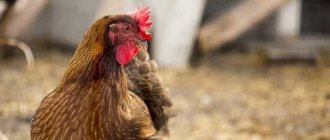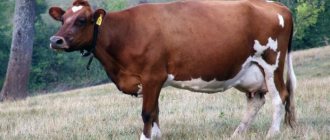The Aberdeen Angus breed of cows confidently ranks first in the ranking of the popularity of cattle. This hornless breed belongs to the meat category and is quite unpretentious in terms of keeping conditions. Breeding this productive and early-ripening breed is a profitable activity that allows you to obtain valuable “marbled” meat.
From the history of the breed
The Aberdeen Angus breed was developed in Scotland in the 19th century. Its name comes from the Scottish counties of the same name. Already at the end of the 19th century, 8.5 thousand Angus animals were delivered to the USA.
Red Angus were bred in the mid-twentieth century. But American breeders refuse to recognize their belonging to the breed.
In North America, black Angus breeding has become widespread, and their meat has become an ideal raw material for the famous American steaks. US farmers promptly organized the Angus Breeders Association, and then created a stud book, which includes only individuals that meet certain requirements.
Breeding history
This breed comes from British polled cows. They were used for a long time as working animals in Aberdeen and Angus, two Scottish counties. Having an interesting location in the temperate climate zone, this place was perfectly suited for the formation of rich flood pastures. It was here that hornless cattle were grazed.
recommended articles:
- Domestic geese and what a farmer needs to know about them
- Caring for turkey poults: how and what to feed from the first days
At one point, local breeders decided to focus on exterior characteristics, early maturity and obtaining a higher slaughter yield in cows, and at the same time improve their meat qualities. 1775 can be considered the year of the appearance of the Aberdeen Angus breed, but animals began to be sold much later.
Thanks to their precocity, cows quickly spread everywhere. Both European farmers and livestock breeders from the former republics of the USSR are engaged in their breeding. Animals have become popular in distant Australia, Argentina, Canada and New Zealand.
Where are they distributed?
Angus are widely reared in:
- Russia;
- USA;
- New Zealand;
- Japan;
- Canada;
- Great Britain;
- Argentina.
Huge black cows are very hardy - Scotland is not the warmest country, so the animals tolerate low temperatures and drought well.
The breed was brought to Russia in 1958. Since then, a gradual increase in their population began. Today they are raised not only for meat, but also used for breeding work to improve the characteristics of local Russian breeds. Places of distribution of the breed in Russia:
- Caucasus
- Stavropol region
- Altai
- Krasnoyarsk region
- Volgograd region
- Voronezh region
- Orenburg region
The breed is actively grown in Kazakhstan and Ukraine.
Maintenance and care
One of the main advantages of the breed is its low maintenance requirements. Let us consider in detail the necessary conditions in winter and summer.
Summer playground
It is advisable that the summer area be surrounded by bushes and trees to create natural shade. It wouldn't hurt to have a body of water nearby.
The animals have thick, dark-colored fur, which is known to attract heat from the sun. To prevent the cows from overheating, you need to make a canopy, which will also serve as shelter during precipitation.
Arrangement of the barn
During the winter, animals are transferred to a barn or barn. The room needs to be made spacious, dry and bright. The stall is about two meters long for the cows to lie down. Make the floor sloping and remove drains to remove excrement.
The bedding layer is approximately fifteen centimeters, this is enough to protect heifers from developing mastitis. Typically, straw or sawdust is used for bedding; if the room has a concrete floor, then it is advisable to purchase rubber mats.
The material for feeders and drinkers can be anything: wood, plastic, metal, the main thing is that it is not toxic. Animals must have free access to food and water.
Important! If animals of different sexes and different ages are kept, they must be separated with bars to avoid injury.
Conditions of detention
There is no need to insulate barns, since animals have thick fur. Their body heat is provided by a dense layer of fat. Angus are accustomed to cold and wet climates. Therefore, they can withstand even very low temperatures.
Animals do not tolerate heat as well as cold, so the room should be ventilated, but without drafts.
The light in the barn should be on 24 hours a day.
Regular cleaning of stalls and equipment
Animal bedding is changed as it gets dirty to avoid infections. Clean feeders from food debris and wash water containers, otherwise they may harbor pathogenic bacteria.
Clean drainage areas and floors from feces twice a day. Once a week they carry out general cleaning, disinfecting the room with slaked lime. Inspect the ventilation pipes and clean them of dust. In addition, all work equipment is thoroughly washed and disinfected.
Features of the Aberdeen Angus breed
The main distinguishing feature of Aberdeen Angus cattle is the excellent taste of the meat product. Aberdeen meat has a special structure - thin layers of fat are evenly distributed throughout it. Aberdeen beef is the only meat that does not deteriorate over time. It doesn’t need to be eaten fresh – as it “ripens” it only becomes tastier.
Advantages of the breed:
- They are characterized by high meat productivity. High taste qualities of meat - due to thin layers of fat, meat acquires a unique “marble” structure.
- Large weight and size. They quickly gain weight and increase in size. To avoid obesity, it is important to ensure proper nutrition for livestock.
- Poledness (hornlessness). This is a dominant trait that is actively transmitted by Angus during crossing - in almost 100% of cases.
- Fast weight gain. Calves are born small, their weight is 22-23 kg and 25-26 kg for heifers and bulls, respectively. Heifers are inseminated at 14-15 months. And by the age of two years, bulls have the parameters necessary for slaughter.
- Easily acclimatize to difficult climatic conditions.
- When crossed, the advantages of the breed are well conveyed - meat qualities, precocity and hornlessness.
- Prolific. Retain reproductive abilities throughout life. Almost zero mortality in calves - they have strong immunity and excellent health. Females are excellent mothers.
- They live long. Average life expectancy is 28-30 years.
- Calving is easy. Calves are not large, so problems usually do not arise during calving.
- High productivity.
Benefits of Aberdeen Angus cattle
Endurance and frost resistance
Animals of this breed acclimatize well and easily tolerate high and low temperatures, so they can be kept outside all year round. At the same time, they continue to gain weight on average 0.7 - 0.8 kg per day (up to 2-3 kg during very intensive fattening), the main thing is to provide enough good quality feed.
High quality marbled beef
In terms of taste and nutritional qualities, their meat is not inferior to Herefords and is considered ideal for steaks - the so-called “marbled” beef, tender, juicy, with thin layers of fat. This structure of meat occurs due to the fact that in Aberdeen Angus cattle the bulk of the fat is deposited not under the skin, but in the thickness of the muscles.
Marbled Aberdeen Angus meat
The highest value meat is certified by the US Department of Agriculture with the label “Certified Angus Beef”. Such markings can be placed on cattle meat of other breeds if they meet high requirements for carcass quality, conformation and age of the animals.
Poledness and excellent meat properties are transferred to calves even when crossed with cattle of other breeds. Angus are usually crossed with dairy breeds to improve the meat quality of the latter or improve the health of the herd. Aberdeen Angus are considered the best beef breed in the world in terms of carcass appearance, meat quality and growth rate.
In addition, this is the fastest breed : heifers are bred at 14-15 months (not 18, as for most breeds) with a minimum weight of 320-350 kg; at 18 months, bull calves weigh 450-500 kg.
Representative of the early maturing Aberdeen Angus cattle breed
Economically profitable breed : there is no need for large heated barns, a large amount of feed and expensive treatment. Angus have good health and can remain free-grazing all year round if food is available.
Small calves at birth, easy calving. Aberdeen Angus calves are born weighing 16-23 kg, while other breeds weigh 20-30 kg. Due to the low birth weight, calving is easy, without complications, even for first-time heifers. From the first day, calves graze with their mother and remain suckled until they are 8 months old.
High yield of calves per 100 cows - 95-99% (up to 100%) , almost zero calf mortality. Calves have good health and high immunity, which they receive from their mother during the suckling period. Cows have good maternal qualities.
Aberdeen Angus calves
Constitution and exterior
Signs that allow you to unmistakably determine that this is a representative of the Aberdeen Angus breed:
- No horns. Moreover, both in cows and in bulls. The absence of horns complicates life only in the wild, but in home breeding this feature is simply a distinctive feature and dominant of the breed.
- Black suit. There are also Red Angus, whose belonging to the breed is denied by American farmers.
Appearance features:
- Head. Powerful and heavy. But small in size. The animal looks very harmonious - Aberdeen are the real elite of the cow tribe. The forehead is slightly moved forward - as if Angus are angry, the back of the head is narrow. The muzzle is neat and short.
- Torso. They have a wide, deep and heavy body - the cattle look very powerful and strong. The line of the back is almost flat - without deflections.
- Legs. They are forced to carry a large mass, so they are very powerful and muscular - this can be seen with the naked eye. There's a lot of meat on the legs. The legs are short, they stand firmly and evenly on the ground.
- Neck. She is almost invisible - her head seems to immediately go into her shoulders. This feature adds visual power and strength to the exterior.
- Loin and cross. The leg is round in shape, with well-developed muscles.
- Wool. Brilliant. Well protects from the scorching sun and wind.
If Angus are well fed, they have a round shape and look powerful and muscular.
Animal muscles are clearly visible through thin, loose and elastic skin. Angus are distinguished by thin bones - it makes up no more than 15-18% of the total carcass weight. Other parameters are given in Table 1.
Table 1
| Parameter | Breed standard |
| Oblique length of the body, cm | 135-140 |
| Height at withers, cm | 120 |
| Chest width, cm | 46 |
| Chest depth, cm | 67 |
| Live weight of cows/bulls, kg | 450-500/900-1000 |
| Slaughter yield, % | 62-67 |
| Average milk yield per year, l | 1700 |
Aberdeen are large and powerful animals, their appearance can even frighten. However, these black, strong creatures have a very docile character and are not known to show aggression. Only bulls at puberty can be quite ferocious.
Kalmyk breed of cows
The Kalmyk breed appeared at the beginning of the 17th century in the southeast of the RSFSR, with a dense constitution, very hardy, grazes well on scarce pastures, and quickly gains weight in the spring. The color is red in all possible shades, with a white stripe along the entire length of the spine and with a white head. The head is not large, the forehead is shortened, the horns are small, the nasal part of the skull is humpbacked. The animals are medium-sized, compact in build. The withers, back, and loin are level and fairly wide. The chest is quite deep, the dewlap is well developed. The sacrum is slightly elevated. The legs are strong, the muscles are well developed, the skin is medium, covered in winter with long thick hair, which protects well in severe frosts.
Calves weigh 22-28 kg at birth, and 202-220 kg by 8 months. The average weight of cows is 510 kg. Bulls - from 752 kg to 1205 kg. Bottomhole yield from 55 to 60%.
The main advantages include:
- possibility of year-round maintenance on pastures,
- grazes well even on poor pastures,
- very high endurance,
- The meat is juicy, evenly covered in fat, with ideal taste and nutritional qualities.
Are there any disadvantages?
According to the description, the breed is magnificent, but does it really have no disadvantages? There are, but they are not so significant compared to the advantages:
- Weak legs.
A contradiction arises - it is simply difficult for a fattened animal to carry its body. Despite the development of the leg muscles, the strength of the legs is not enough to support the obese carcass - the animal begins to fall on its feet. This is why Aberdeen should not be overly fattened. Bulls will be sent to slaughter anyway, so weakness in the legs is not so important, but cows should not be allowed to be overweight! Obesity in cows leads to difficulty transferring weight during gestation and complications during calving. - Arched back. Connoisseurs of cow conformation claim that the carp-like back somewhat spoils the attractiveness of Angus. But this does not affect the quality of the meat in any way! This disadvantage even has its advantages - the structural features allow livestock to easily adapt to external environmental conditions.
- Need large pastures. That is why the breed is more suitable for farmland and hunting grounds.
Productivity
Cattle breeders raise black Scottish cows only for meat - that very valuable marbled beef. What you need to know about Angus productivity:
- The carcass yields 60% pure meat - this is extremely high productivity.
- The female weighs on average 500-600 kg, and if she is fattened purposefully - 700 kg.
- Bulls reach 1000 kg. They are slaughtered at a young age - while the meat is soft and tender. The ideal age for slaughter is 1.5-2 years.
- Over six months, the calf gains weight 152-158 kg - from 22-28 (calf weight) to 180 kg.
Tasters specializing in meat can determine by taste the age at which the animal was slaughtered. It has been noticed that over the years, Aberdeen meat becomes tougher, but in all other respects it only improves.
Angus are the clear leaders in early maturity and meat characteristics among beef cattle. The weight of cows depending on age is presented in Table 2.
table 2
| Periods of life | Floor | Weight, kg |
| at birth | chicks | up to 20 |
| bulls | until 23 | |
| 7-8 months | chicks | 160-180 |
| bulls | 180-200 | |
| 16 months | fattening bulls | 450-460 |
| adult | cows | 500-700 |
| bulls | 750-1000 |
Being on suckling for up to 8 months, calves gain 800-900 g per day. And one cow produces 1600-2000 liters of milk during lactation. Typically, lactating cows are not milked - the milk is used to feed the calf. After 8 months of the dairy kitchen, the calf will weigh about 230 kg.
Appearance
Among a large herd of cows, the Aberdeen Angus breed (see photo) is not difficult to spot.
Exterior features are presented in the table.
| Part of the body | Description |
| Height | Small, on average 120-150 cm at the withers |
| Color | Red Black |
| Limbs | Short |
| Shoulders | Muscular |
| Horns | None |
| Outer cover | Thin, elastic |
| Breast | Chest width 46-66 cm |
| Neck | Short |
| Wool | Small hair |
| Body | Wide. The back, lower back and sacrum are straight |
| Weight | Cows – from 400 to 700 kg, bulls – from 800 kg and above |
Content requirements
For the growth and development of Aberdin, a natural food supply is sufficient - they need extensive pastures, natural or artificial meadows. They tolerate cold and heat well, so as long as snow does not fall and frosts do not hit, they can graze on the paddock.
Angus dogs can be free ranged all year round.
Recommended walking conditions:
- It is desirable that shrubs and trees grow along the perimeter of the pasture - then animals can wander around, chewing grass, without any supervision or care.
- If there are no trees nearby, it is recommended to make a canopy from the sun so that animals can hide under it during the high solstice hours.
- The main task of the herd owner is to provide the cattle with water and mineral supplements; the cows will find everything else themselves. In the absence of a natural reservoir, you need to organize drinking bowls.
- When keeping a barn, it is important to keep everything clean - remove manure and any debris.
Thanks to its natural content, livestock meat acquires a special taste - delicate and refined.
If Angus have water and food, they can stay outside even during the cold season. In winter, cattle can be driven into barns - here they are kept without a leash. Moreover, there is no need to insulate the room - animals warm themselves from the heat generated by their bodies.
Experts talk about the peculiarities of keeping the Aberdeen Angus breed outdoors. The video shows a special feedlot for livestock:
Content
Angus dogs adapt well to any climate, tolerate heat and frost well, and are not afraid of snow. These animals need extensive pastures, cultivated or natural (meadows). There will be no need for shelter from the sun - trees or bushes, a small grove or a canopy.
In the warm season, if there is a sufficient amount of green feed, the farmer’s only task is to provide access to water (drinking bowls, pond) and mineral supplements.
During the cold season, Angus can be left outside if they have access to food and water.
If in winter it is not possible to organize feeding and watering outside, Angus can be kept in a barn without a leash. There is no need to insulate the barn; the animals stay warm thanks to the heat they generate.
Features of calving cows
After a nine-month pregnancy, the cow gives birth to one, or less often two, medium-sized calves, each weighing from 15 to 23 kg. Due to the small size of the calves, childbirth is easy, without complications; the cow copes on her own even at the first calving.
Aberdeen Angus cows are caring mothers, so calves have strong immunity and very rarely get sick.
When kept on free pasture, cows become so weaned from humans that at the time of weaning the calves can behave aggressively.
Nutrition
The basis of the diet of Aberdeen cats, which graze on range most of the year, is green food. Since there is no food on the streets in winter, the cattle are given high quality food:
- silage;
- hay;
- roots;
- crushed grain;
- compound feed
It is important to follow nutritional standards so that the livestock does not become fat. Cattle of this breed have a high feed conversion rate. For an animal to gain 1 kg of weight, it needs to consume 6.5 kg of feed units, this can be:
- dry oats – 6.5 kg;
- or meadow grass – 32.5 kg;
- or hay – 13 kg.
Mineral supplements:
- bone flour;
- defluorinated phosphate;
- tricalcium phosphate;
- diammonium phosphate and others.
In order for the meat to have the excellent taste characteristic of this breed, it is not necessary to use concentrates for feeding.
Constantly being on pastures, good-tempered Angus can show distrust of the owner - they simply forget about his existence. It happens that cows try to leave the herd - this must also be taken into account when breeding Aberdeen. Another problem is the maternal instinct of cows. The female may attack a person if she decides that her calf is in danger. And even the absence of horns in Angus will not help a gape person.
Feeding
Angus spend most of the year on pasture, so their main diet is green food ad libitum. In winter there is no green feed, so the cows are given hay, silage, crushed grain or mixed feed.
It is necessary to accurately calculate the nutritional value of the diet in order to avoid obesity, to which animals of this breed are prone. With year-round grazing, the taste of meat becomes subtler, as if it absorbs the aromas of meadow herbs.
Angus have a very high feed conversion - for 1 kg of growth only 6.5 feed units are required - this is 6.5 kg of dry oats of average quality, OR about 32.5 kg of meadow grass, OR 13 kg of hay of average nutrition.
As a supplement to the basic diet of calves, add:
- premixes;
- combined feed;
- finely crushed grain;
- various mineral supplements.
Young animals should be accustomed to any of these food components gradually. In addition, it is extremely important to monitor the amount of food fed to the animal.
This type of cattle grows intensively for an extremely short period of time. If the animal's menu is not adjusted in time, it will quickly begin to develop obesity.
Important! In summer, in addition to green food, it is necessary to install feeders with mineral fertilizers outside. You should also ensure that animals have free access to water.
Fattening
The best meat comes from castrated bulls. Castration is also carried out in calves. Thanks to castration:
- meat fibers become thinner and meat more tender;
- bulls can graze in the same herd with cows; there is no need to organize a separate pasture for them;
During fattening, the basis of the diet is:
- crushed grain;
- hay;
- compound feed - however, they worsen the taste of meat;
- premixes – vitamin and mineral.
Feeding rates for livestock during fattening, giving an average daily weight gain of up to 800 g, are given in Table 3.
Table 3
| Index | Age, months | |||||
| 9-10 | 11-12 | 13-14 | 15-16 | 17-18 | 19-20 | |
| Live weight at the end of the period, kg | 245 | 290 | 335 | 380 | 425 | 470 |
| EKE | 5,9 | 6,3 | 6,6 | 7 | 7,4 | 8,1 |
| Metabolic energy, MJ | 59 | 63 | 66 | 70 | 74 | 81 |
| Dry matter, kg | 6,4 | 6,8 | 7,2 | 7,7 | 8,2 | 9 |
| Crude protein, g | 800 | 820 | 848 | 920 | 965 | 1059 |
| Digestible protein, g | 525 | 560 | 565 | 605 | 632 | 677 |
| Crude fiber, g | 1570 | 1700 | 1870 | 2090 | 2370 | 2491 |
| Starch, g | 768 | 813 | 879 | 980 | 1066 | 1170 |
| Sugar, g | 390 | 398 | 400 | 416 | 430 | 472 |
| Crude fat, g | 180 | 194 | 207 | 230 | 240 | 263 |
| Table salt, g | 31 | 34 | 36 | 40 | 42 | 46 |
The farmer tells how the farm organizes the fattening of bull calves for meat, and what are the features of their feeding:
Fattening for marbled meat
To achieve the famous marbled meat from their cattle, farmers mainly breed Aberdeen Angus bulls. They are slaughtered at about one and a half to two years.
The highest quality meat can be obtained from castrated bulls, which undergo castration as calves. Then the structure of the product fibers will be thinner and more delicate.
Aberdeen Angus bulls are fattened using a large amount of crushed grain, hay, vitamin supplements, mineral premixes and feed mixtures. Also, breeders limit their physical activity 3-4 months before receiving meat so that they do not waste calories.
Bulls are slaughtered every year and a half. By this time, they have already reached a certain weight, and their further growth can have a bad effect on the fat layer and the quality of the steaks. Slaughter yield varies from 60 to 70%, bone content - from 17 to 18%.
Breeding
Breeding Angus is a profitable business, as their young animals have a high survival rate. Calves are born strong, with good immunity. Feeding on mother's milk, they receive the entire complex of minerals and vitamins.
From 14 months, cows are ready for insemination. They can bear offspring annually. Aberdeen cows often give birth to two calves at once. They are caring mothers:
- feed the calf daily - up to 8 months;
- looks after the offspring;
- protects his calf from any danger.
Cows and calves can be safely released to free grazing - the females will take care of the protection of the young.
A cow's pregnancy lasts 9 months. The birth goes smoothly. Typically, farmers keep 1-2 bulls to improve the herd.
Advantages and disadvantages
The breed inherited many positive characteristics from its ancestors when crossed:
- High productivity rates.
- Cattle meat is tasty, nutritious, beautifully structured, juicy (fat layers are evenly distributed).
- Individuals are large and heavy. They grow quickly.
- Cows and bulls do not have horns (polled).
- Calves have good indicators of early maturity. After birth, they gain one kilogram per day. By the age of two they reach the permissible weight for slaughter.
- Carcasses contain about 70% meat, low percentage of fat and bones.
- Individuals quickly get used to the climate and living conditions. Frost-resistant.
- The breed is crossed with other species. Meat qualities, endurance, early ripening and polledness are well transmitted.
- Females are fertile. Capable of producing offspring throughout life. The first offspring is born at 13-15 months. Maternal instinct is well developed. They protect and feed calves with milk until they are 7-10 months old.
- Bulls reach puberty at 2.5-3 years.
- Calves are born small. The female usually has no problems during pregnancy, and childbirth is easy. It's not uncommon to have twins.
- The life expectancy of cows is on average 30 years.
The breed has a number of significant disadvantages that also need to be taken into account:
- Individuals are prone to obesity. The quality of meat is deteriorating.
- The skeleton is thin with a large mass; fractures of the limbs may occur.
- Requires free grazing in a spacious area.
- A long stay on a pasture range in a deserted area leads to wildness and aggression.
- Females do not produce enough milk to generate additional profit from rearing.
How is calving going?
The room must be dry and clean. Stock up:
- two towels;
- gauze;
- soap;
- iodine;
- threads;
- bandage;
- 100 g vegetable oil;
- warm water;
- potassium permanganate solution;
- sheets;
- burlap;
- straw rope.
As soon as the cow begins to show anxiety and starts looking around, you need to wash the back of the body and genitals with potassium permanganate. The solution is made slightly pink. Lay dry straw near the cow.
Less than an hour later, the calf is born. It is placed on a clean sheet. The umbilical cord breaks on its own; if it does not break, it must be cut off, leaving 10 cm from the calf’s belly. All that remains is to tie the umbilical cord with threads and treat it with iodine.
Diseases
From a genetic standpoint, black and red Angus breeds are identical. But it is believed that red cows are less cold-resistant. However, there is no scientific evidence for this. Aberdeen are carriers of 4 recessive genetic diseases. They appear when both parents have the gene. According to statistics, even under such conditions, only one out of 4 calves gets sick.
To identify carriers of bad genes, a DNA test is performed on individuals.
Genetic diseases:
- Contracture arachnodactyly. There is a deterioration in the mobility of the hip joints.
- Arthrogryposis multiplex . Crooked joint disease. Breeders call calves with this condition “twisted.” The joints have poor mobility, and the leg muscles are atrophied.
- Neuropathic hydrocephalus . It is also called dropsy of the brain. Calves have large, shapeless heads.
- Dwarf traits.
- Notomelia. Extra limbs.
- Osteoporosis. Brittle bones.
Calves with such genetic diseases are culled - they are not suitable for breeding. A cow's pregnancy lasts 9 months. The birth goes smoothly. Typically, farmers keep 1-2 bulls to improve the herd. Purebred Aberdeen Agnus cows should be purchased from breeding farms. Here you can get material for insemination.
Breeding farms in Russia that have breeding stock:
- "Paris Commune" - in the Volgograd region;
- "Avryuz" - Bashkortostan;
- LLC "Sputnik" - in the Leningrad region. Vsevolzhsky district, village. Lepsari;
- State Unitary Enterprise ESH "Dyatkovo" - in the Bryansk region. and many others.
Livestock health status
Red and black Angus are genetically very similar, but it is generally accepted that Red Angus are less adapted to cold weather. Aberdeen Angus dogs are predisposed to four genetic diseases that occur when both parents have the diseased gene. According to statistics, one calf out of five is sick.
These diseases are:
- Neuropathic hydrocephalus is a brain disorder in which calves are born with large, irregularly shaped heads.
- Arthrogryposis is a disease of the leg joints in which the cow's joints become twisted and the muscles lose tone.
- Dwarfism - Calves are born very small and grow very slowly afterwards.
- Notomelia is an increased number of limbs.
Cattle with such diseases are not used for insemination.
You can also get an Angus cow for home keeping in a herd of several individuals; you can breed it or cross it with other breeds. Thanks to their meat orientation and excellent adaptability to adverse weather conditions, Aberdeen dogs will delight their owner not only with high-quality meat, but also with improved milk performance in the herd.
Calf care
The keeping of calves is divided into milk and post-milk periods. The most important stage in the life of a calf of any breed is the first two weeks. Angus breed very strong offspring. The mortality rate is practically zero. Conditions for keeping calves during the first 14 days:
- Calf nurseries should be located in a room with good ventilation and lighting.
- The barn where the calves are kept must have a constant temperature.
- There should be no drafts. Calves have poorly developed body thermoregulation, and changes in temperature will negatively affect their health. Angus, having a strong immune system, unlike calves of other breeds, practically do not get sick.
- The nursery must be kept clean to prevent infectious diseases.
Calves get all their nutrients and immune substances from colostrum, which is the nutritional fluid the cow gives after calving. Immediately after birth, the calf must suckle the udder.
Please note the following points:
- For the first time, the calf should drink 1-2 liters of colostrum.
- The frequency of feedings should be 4-5 times a day.
- If the calf is weakened, it should eat more often - 5-6 times 1 liter, then 2 liters.
- The daily norm of colostrum is 8-10 liters.
- On the 5th day, the calf is given boiled water. Its temperature should be the same as that of fresh milk – 37 °C.
- From the 7th day - to develop digestion, calves are given small-stemmed, high-quality hay.
Calves are weaned from their mother at the age of 6-8 months. Calves enter the post-milk period of development. Calves need to get enough sun to produce vitamin D, which is needed for bone growth. Gradually, the calves switch to an adult diet, walking on pastures with cows, they have access to nutritious green food.
What to feed
Angus are not picky animals; their diet almost all year round, except winter, consists of fresh meadow grasses. Still, there are some nuances that a novice breeder needs to know.
Summer grazing on a pasture
Throughout the warm period of the year, while the meadows are full of grass, the cows are kept grazing. They do not require any additional feeding. All you need is constant access to water; briquettes with salt are also installed under the canopy.
It is necessary to inspect the pasture for poisonous herbs (henbane, datura, St. John's wort). In addition, grazing areas should be given rest for about three weeks to prevent the land from becoming depleted.
Feeding diet in winter
In winter, animals are fed hay, root vegetables and vegetables, and mineral supplements.
The diet includes:
- pull corn;
- cake;
- bran;
- meadow grass hay;
- silage;
- compound feed;
- potatoes, beets, carrots.
Be sure to give up to eight grams of salt per day.
Angus are prone to obesity. Excess weight puts more stress on the limbs, which can lead to injury. Therefore, it is important to follow a diet:
- three to four feedings per day;
- 2/3 of food comes in the first half of the day;
- feed is strictly dosed (based on weight and desired growth).
Did you know? In one minute, a cow makes about a hundred chewing movements.
Water
Fresh water must always be available to animals, otherwise problems with the digestive system will arise. The water should be at room temperature and always clean. About one hundred liters are needed per individual. Change the water twice a day.
Comparison with “competitors”
Angus differ from other breeds:
- Good health and low mortality among calves.
- They rarely get sick, and even genetic diseases affect only 25% of calves if both parents have the disease gene.
- They can graze on range all year round.
- Lactating calves – up to 8 months, instead of 3.
- Calves are born small - only 16-23 kg, while in other breeds - 20-30 kg. Therefore, childbirth is easy and without complications, even in first-calf heifers.
- Calves can graze with their mother from the first day of life.
- They are characterized by high early maturity.
Main competitors:
- Herefords. This is the most common breed. They, like Angus, can easily withstand harsh conditions and can graze year-round. They are distinguished from Angus by their more powerful front part. In many ways, the breeds are similar; Herefords are also distinguished by easy calving, fertility, low calf mortality, longevity, and high feed conversion. And most importantly, they also produce excellent “marbled” meat.
- Simmentals. Another popular meat breed. They are also large and muscular, like the Aberdeen. In addition, Simmentals are characterized by high milk production. The meat is devoid of excessive fat deposits, but in terms of taste it is inferior to Hereford Angus meat.
- Limousines. Like Aberdeen, they are distinguished by easy calving and good weight gain; their meat contains little fat. But they are extremely demanding in terms of food and living conditions; they are considered conditionally suitable for year-round grazing.
Table No. 4 shows a comparison of the economically useful qualities of Angus, Simmental, Hereford and limousine:
Table 4
| Indicators | Bulls | Cows | ||
| Herefords | ||||
| Height at withers, cm | 140-150 | 135-140 | ||
| Weight, kg | 1000-1200 | 600-750 | ||
| Daily weight gain of calves, g | 900-1300 | 850-1100 | ||
| Angus | ||||
| Height at withers, cm | 130-150 | 120-140 | ||
| Weight, kg | 900-1200 | 500-700 | ||
| Daily weight gain of calves, g | 1000-1200 | 850-1100 | ||
| Simmentals | ||||
| Height at withers, cm | 150-160 | 140-145 | ||
| Weight, kg | 1200-1400 | 750-800 | ||
| Daily weight gain of calves, g | 1200-1400 | 900-1200 | ||
| limousines | ||||
| Height at withers, cm | 145-155 | 135-140 | ||
| Weight, kg | 1000-1200 | 650-700 | ||
| Daily weight gain of calves, g | 1100-1300 | 900-1100 | ||
The Aberdeen Angus breed is a real treasure of livestock breeding. This breed is one of the few that does not require special care - the animals are ready to live in their natural environment all year round. They do not require supervision; care for the herd is minimal. By breeding Angus, you get a precious product - unique, juicy meat that is highly valued.
0
0
Copy link
Meat productivity
Live weight of cows is 500-700 kg, bulls - 750-1000 kg; castrated bulls by 15-16 months with intensive rearing and fattening 450-460 kg; the weight of calves by 7-8 months of age is up to 200 kg; the weight of newborn heifers is 16 kg, bulls 25 kg.
Calves are raised on suckling for up to 8 months, which is facilitated by the highly developed maternal instinct of cows. The average daily gain is 700-800 g, the slaughter yield is about 60%. Feed costs per 1 kg of weight gain are 6.5 feed units.
In terms of taste and nutritional qualities, their meat is not inferior to Herefords and is considered ideal for steaks - the so-called “marbled” beef, tender, juicy, with thin layers of fat.
This structure of meat occurs due to the fact that in Aberdeen Angus cattle the bulk of the fat is deposited not under the skin, but in the thickness of the muscles.
The highest value meat is certified by the US Department of Agriculture with the label “Certified Angus Beef”. Such markings can be placed on cattle meat of other breeds if they meet high requirements for carcass quality, conformation and age of the animals.











